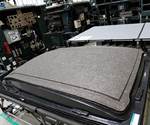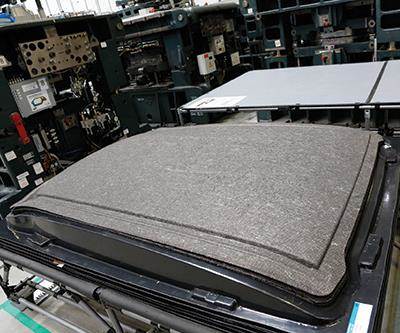Recycled carbon fiber update: The supply side
Commercial recyclers aren’t alone in their pursuit of fiber reclamation. Textile converters have joined the effort.
Commercial recyclers aren’t alone in their pursuit of fiber reclamation. Textile converters have joined the effort, enjoying a plentiful and secure supply of internally generated raw material.
FORMAX (Narborough, Leicestershire, U.K.), for example, is converting virgin fiber waste from its manufacture of noncrimp fabrics (NCF) into nonwoven mats that can be used in composite parts. According to Managing Director Oliver Wessely, waste such as edge trim is cut off, sucked into a vacuum and converted into a discontinuous fiber sheet, which “can then be used as a print-stop barrier or bulking layer in infused marine or architectural parts, for example.” FORMAX is also developing materials for use in Class A surface automotive parts. “The discontinuous fibers produce absolutely no print-through,” claims Wessely, “and also enable good formability for parts with complex geometry.” He asserts the material processes well in press molding and would be ideal for fabricators who currently use sheet molding compound (SMC). “It can produce very good properties depending upon the resin and process used,” he claims, ”and is being trialed now at a number of our automotive customers who are expressing great interest.”
With current production at 700 metric tonnes of carbon fabric annually (over 1.5 million lb/yr), and 7 percent waste, Wessely says FORMAX already has a good supply, “but as we grow this will only increase. Also, our customers are typically generating 25 percent waste from nesting as they cut out plies prior to preforming and/or laying and we also run this through our process.” He says the company is now transitioning from lab scale to commercialization. Fiber lengths range between 50 and 75 mm (2 and 3 inches), with the original applied sizing intact, and the resulting textile reportedly drapes and handles like a heavy veil.
Likewise, Sigmatex (Norton, Cheshire, U.K.) is also collecting dry carbon fiber production scrap — discontinuous virgin fibers mainly between 45 and 60 mm (1.8 to 2.4 inches) long — which it then combines with thermoplastic and weaves into tapes or noncrimp fabric (NCF) with more than 60 percent tensile strength and 90 percent modulus vs. VCF fabric at a lower price. “We worked with the U.K. government-funded FiberCycle program, where the aim was to develop this for large-scale composite applications,” says commercial manager Mike Hitchen. He notes that these RCF products are marginally cheaper than NCF using the most cost-effective virgin fibers, but that real cost reduction is achieved through reduced part cycle time through heated press stamping and the removal of resin from the manufacturing process. The first commercial SigmaRF product is a ±45 biaxial 220 g/m2 (6.5 oz/yd2) NCF. It contains 3 percent PET stitching thread and is 48 percent CF by weight. Sigmatex has sold the fabric into press-molded parts for an automotive component and also developed options using polyamide (PA), polyethersulfone (PES) and polyetherimide (PEI).
Editor's note: This short article is a sidebar to a feature article titled "Recycled Carbon fiber update: Closing the CFRP Lifecycle Loop." To read the main article, click on its title under "Editor's Picks," at top right.
Related Content
Mar-Bal expands SMC expertise through AltraSet materials division
The BMC company aims to fill the SMC market gap for those seeking optimal, low-volume demand with custom formulation and high material value.
Read MoreAOC resins support SMC composite doors for air raid shelters
The recent use case exemplifies the application of AOC’s SMC resins in related fields, thanks to their strength, resistance and longer lifespan in comparison to metal or fiber-reinforced concrete options.
Read MoreSMC, compression molding capabilities to support European composites manufacturers
JEC World 2025: SFG Composites presents its ability to deliver high-quality, cost-effective composite solutions in-house with fast lead times as an alternative to domestic and Asian suppliers.
Read MoreIDI Composites opens new global headquarters, manufacturing and technology center
The Noblesville, Indiana, facility includes SMC and BMC manufacturing, an R&D center and the company’s corporate headquarters.
Read MoreRead Next
Recycled carbon fiber update: Closing the CFRP lifecycle loop
Commercial production of recycled carbon fiber currently outpaces applications for it, but materials characterization and new technology demonstrations promise to close the gap.
Read MoreCeramic matrix composites: Faster, cheaper, higher temperature
New players proliferate, increasing CMC materials and manufacturing capacity, novel processes and automation to meet demand for higher part volumes and performance.
Read MoreNext-gen fan blades: Hybrid twin RTM, printed sensors, laser shock disassembly
MORPHO project demonstrates blade with 20% faster RTM cure cycle, uses AI-based monitoring for improved maintenance/life cycle management and proves laser shock disassembly for recycling.
Read More












